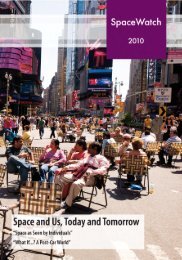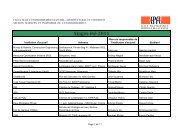laba manifest - ENAC | School of Architecture, Civil and ...
laba manifest - ENAC | School of Architecture, Civil and ...
laba manifest - ENAC | School of Architecture, Civil and ...
Create successful ePaper yourself
Turn your PDF publications into a flip-book with our unique Google optimized e-Paper software.
Research<br />
<strong>laba</strong> merges analytical research with creative design, seeking to develop <strong>and</strong><br />
refine methodologies which produce ideal solutions for specific programs,<br />
locations, technologies or conditions. Many critical issues influencing<br />
contemporary territories have enormous spatial implications, yet are seldom<br />
addressed by architects. <strong>laba</strong> investigates these issues.<br />
The pressure <strong>of</strong> immigration into European fringe cities (Athens- City <strong>of</strong><br />
Immigrants /<strong>Architecture</strong> <strong>of</strong> Integration lapa 2010/11) <strong>and</strong> the urbanization<br />
<strong>of</strong> the ocean (A Territorial Constitution for the Barents Sea, <strong>laba</strong> 2011/12) are<br />
two examples.<br />
Technological developments such as GIS allow architects to investigate<br />
urban development from any distance. Vast resources <strong>of</strong> information <strong>and</strong><br />
data are available <strong>and</strong> accessible. Sophisticated environmental modelling is<br />
already possible through this technology. Ultimately, environmental factors<br />
influencing cities can be designed <strong>and</strong> tested.<br />
At the same time, to really underst<strong>and</strong> urban phenomena architects need to<br />
do extensive field work. The close-up view <strong>of</strong> urban situations at the human<br />
scale, <strong>and</strong> the “gods-eye” view inform each other respectively <strong>and</strong> are<br />
mutually dependent. Coupling these perspectives <strong>and</strong> utilizing the available<br />
technological resources reveal the true nature <strong>of</strong> a particular urban context,<br />
<strong>and</strong> enable the architect to arrive at specific local solutions for global tasks.<br />
Through the development <strong>of</strong> this set <strong>of</strong> skills, <strong>laba</strong> aims to strengthen the<br />
architect’s position within the urban debate. This approach also informs the<br />
teaching programme.<br />
Currently <strong>laba</strong> maintains a broad research base, drawing on experience gained<br />
from specific design locations where a new urban or territorial condition is<br />
<strong>manifest</strong>ed. Two particular areas <strong>of</strong> interest are;<br />
- design as mediator <strong>of</strong> the urban context<br />
- digital tools <strong>and</strong> their influence on the design <strong>and</strong> production <strong>of</strong> architecture.<br />
<strong>laba</strong>’s research is currently carried out by one post-doctoral position, two<br />
doctorates <strong>and</strong> one research assistant. Further to this, <strong>laba</strong> is committed to<br />
the development <strong>of</strong> an interdisciplinary design doctorate “Complex Design”<br />
at the EPFL through the SNF programme “ProDoc” (application in progress).<br />
Two further research proposals have been submitted in 2012: CH16M2048<br />
(1 doctoral position) <strong>and</strong> WiuUrbis (Waste Impact on Environmental <strong>and</strong> Urban<br />
Design in Romania) part <strong>of</strong> the SNF Romanian-Swiss Research Programme<br />
(two 50% positions) where both partners (EPFL LABA <strong>and</strong> UVT-DG) aim at<br />
identifying the best solutions for environmental <strong>and</strong> urban design in Romania,<br />
which will be used primarily by decision makers in Romania but also by<br />
research circles in both Switzerl<strong>and</strong> <strong>and</strong> Romania.<br />
The project’s solutions are supported by GIS <strong>and</strong> Remote Sensing techniques<br />
<strong>and</strong> incorporate several methods: (a) volunteer mobile information (VGI),<br />
(b) GIS mapping, <strong>and</strong> (c) 3D computer simulations. The other solutions are<br />
<strong>of</strong>fered by architects, who will create waste-management-based urban<br />
design models. The cumulative solutions will contribute, on the one h<strong>and</strong>,<br />
to a better underst<strong>and</strong>ing <strong>of</strong> the problem <strong>and</strong> help raising awareness among<br />
stakeholders <strong>and</strong>, on the other, to the creation <strong>of</strong> an implementable urban <strong>and</strong><br />
environmental design <strong>of</strong> the selected locations.<br />
<strong>laba</strong> <strong>manifest</strong> - june 2012 10





